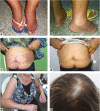Chikungunya virus: clinical aspects and treatment - A Review
- PMID: 28767976
- PMCID: PMC5530543
- DOI: 10.1590/0074-02760170044
Chikungunya virus: clinical aspects and treatment - A Review
Abstract
Chikungunya is a severe and debilitating disease. Currently, Brazil is experiencing an epidemic caused by three arboviruses, which has changed the way health professionals have diagnosed and treated infected patients. The difficulty of diagnosis and the lack of a protocol for patient treatment, which fits Brazilian health system models, have made it difficult to manage this disease. It is necessary to implement a multidisciplinary network of patient care, in which primary care units play the main role. This review aims to present current information regarding the clinical aspects and treatment of Chikungunya virus infection.
Figures

References
-
- Borgherini G, Poubeau P, Staikowsky F, Lory M, Le Moullec N, Becquart JP, et al. Outbreak of chikungunya on Reunion Island: early clinical and laboratory features in 157 adult patients. Clin Infect Dis. 2007;44(11):1401–1407. - PubMed
-
- Bouhassira D, Attal N, Alchaar H, Boureau F, Brochet B, Bruxelle J, et al. Comparison of pain syndromes associated with nervous or somatic lesions and development of a new neuropathic pain diagnostic questionnaire (DN4) Pain. 2005;114(1-2):29–36. - PubMed
-
- Brito CAA, von Sohsten AKA, Leitão CCS, Brito RCCM, Valadares LDA, Fonte CAM, et al. Pharmacological pain treatment in chikungunya: a guideline. Rev Soc Bras Med Trop. 2016;49(6):668–679. - PubMed
-
- Brouard C, Bernillon P, Quatresous I, Pillonel J, Al Assa, De Valk H, et al. Estimated risk of chikungunya viremic blood donation during an epidemic on Reunion Island in the Indian Ocean, 2005 to 2007. Transfusion. 2008;48(7):1333–1341. - PubMed
-
- Chopra A, Anuradha V, Ghorpade R, Saluja M. Acute chikungunya and persistent musculoskeletal pain following the 2006 Indian epidemic: a 2-year prospective rural community study. Epidemiol Infect. 2012;140(5):842–850. - PubMed
Publication types
MeSH terms
LinkOut - more resources
Full Text Sources
Other Literature Sources
Medical

